A couple of super ancient meteorites will be zapped with a high-powered laser as part of a project to protect Earth from violent killer-asteroid collisions that could kill thousands or millions of people, or even destroy life as we know it. A celestial body that could hit Earth and destroy us would not need to be that big, and there are many of them out there, scientists say.
The ancient meteorites, estimated to be about 4.6 billion years old, have survived incredibly long periods of violent collisions in the asteroid belts before raining down on our planet.
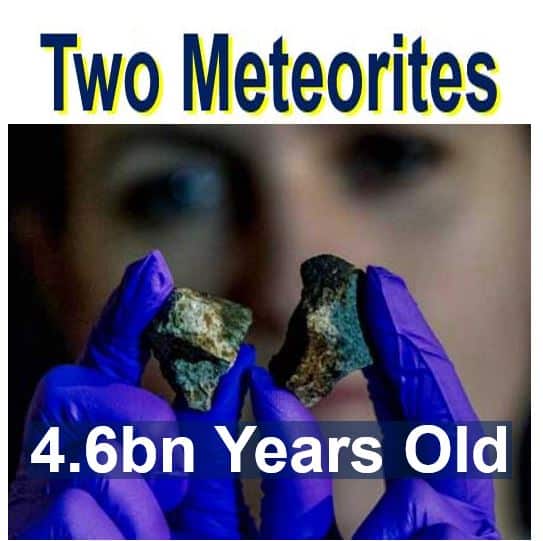 Megan Bruck Syal examining a pair of meteorites destined to be vaporized by high-powered lasers. (Image: llnl.gov. Credit: Julie Russell/LLNL)
Megan Bruck Syal examining a pair of meteorites destined to be vaporized by high-powered lasers. (Image: llnl.gov. Credit: Julie Russell/LLNL)
Two super-ancient walnut-sized meteorites
When Megan Bruck Syal, a postdoctoral researcher at Lawrence Livermore National Laboratory (LLNL), a federal research facility in Livermore, California, received a box, she knew immediately what its contents were: two walnut-sized meteorites that were formed about 4.6 billion years ago.
After finally raining down on our planet, these ancient meteorites were scavenged in Antarctica by scientists, sorted and classified at NASA’s Johnson Space Center, and then packed and delivered first class to Dr. Bruck Syal.
In a few months’ time, these space rocks will be vaporized by a high-powered laser. The data they yield on asteroid deflection will be used to determine how to prevent a killer asteroid from hurting or destroying us.
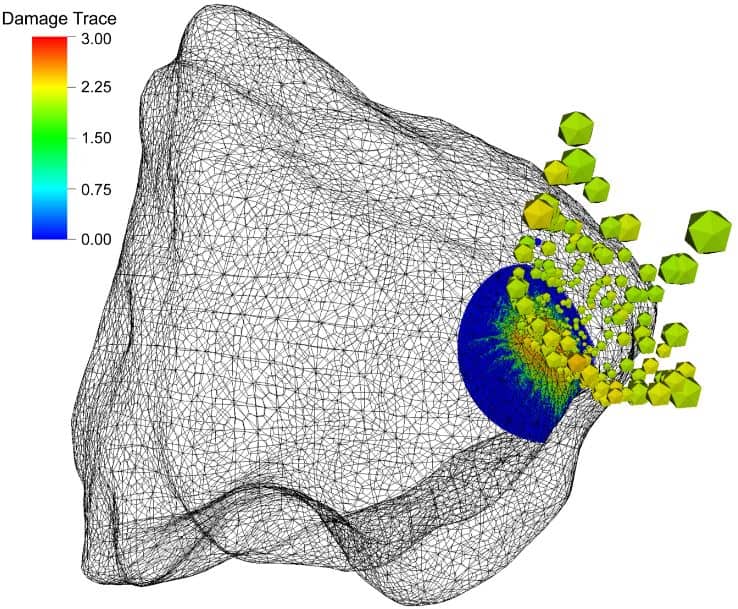 Hitting an asteroid with a projectile to deflect it. Image of asteroid Golevka (500 metres across) impacted by a 10,000 kg mass travelling at 10 km per second along a principal axis of the asteroid. Colours denote the accumulation of damage. In this simulation, Dr. Bruck Syal calculated that the asteroid’s velocity changes by 1 millimetre per second. (Image: llnl.gov)
Hitting an asteroid with a projectile to deflect it. Image of asteroid Golevka (500 metres across) impacted by a 10,000 kg mass travelling at 10 km per second along a principal axis of the asteroid. Colours denote the accumulation of damage. In this simulation, Dr. Bruck Syal calculated that the asteroid’s velocity changes by 1 millimetre per second. (Image: llnl.gov)
Dr. Bruck Syal, a member of Brown University’s Planetary Geosciences Group, who is currently working with an interdisciplinary group of scientists at Lawrence Livermore National Laboratory to investigate several potentially hazardous object mitigation strategies, said “It’s not a matter of if, but when [one of these objects hits us]. Our challenge is to figure out how to avert disaster before it happens.”
She was referring to the eventual certainty of a large celestial object, such as a killer asteroid, crashing into our planet.
Many thousands of NEOs out there
NASA has so far detected 14,000 near-Earth objects (NEOs) – asteroids and comets that have been pulled by the gravitational attraction of nearby planets into Earth’s neighbourhood. Approximately 1,500 new NEOs are identified each year, and NASA calculates the probability of an Earth impact for each one.
Included in that list are over 1,600 ‘potentially hazardous asteroids’ that are less than 20 times the Moon’s distance from Earth. However, what is the good of having all these objects identified and mapped if we do not know how to stop them from crashing into us?
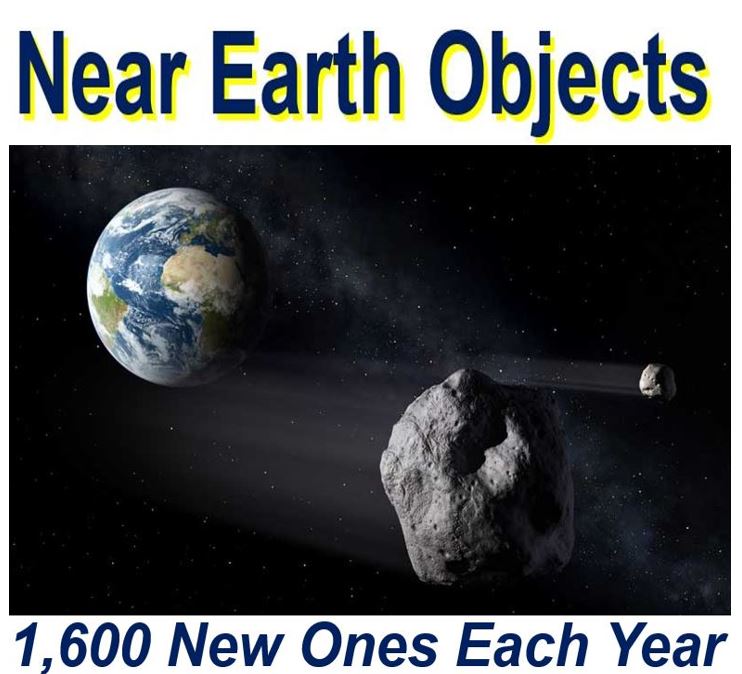 An artist’s depiction of asteroids, or near-Earth objects. (Image: llnl.gov. Credit: ESA)
An artist’s depiction of asteroids, or near-Earth objects. (Image: llnl.gov. Credit: ESA)
Using science to defend the Earth
Dr. Bruck Syal is part of Lawrence Livermore National Laboratory’s (LLNL’s) planetary defense team – a group of material scientists, physicists, computational researchers and engineers working with NASA, Los Alamos and Sandia national labs, as well as collaborators from several different universities and international research centres.
This international coalition of scientists has one challenge – to detect an Earth-bound killer asteroid or comet and deflect it.
The scientists have focused their research on two main ways to deflect a celestial body:
– Hypervelocity projectiles
– Nuclear explosions
The aim is not to destroy the Earth-bound object, but rather to push its trajectory just enough to make it miss our planet. Determining how best to deflect an asteroid is no easy task – it is even more difficult to know that it would work during Earth’s most urgent moment.
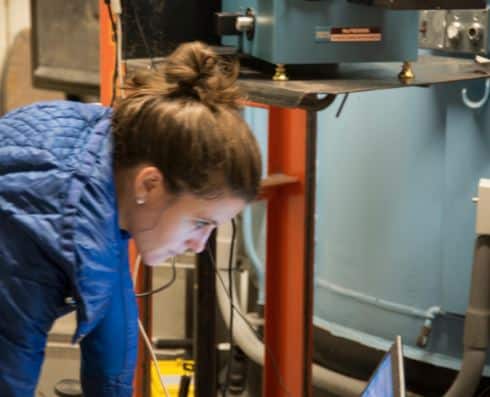 Dr. Bruck Syal writes: “I am currently working with an interdisciplinary group of scientists at Lawrence Livermore National Laboratory to investigate a range of potentially hazardous object mitigation strategies.” (Image: twitter.com/meganimpact)
Dr. Bruck Syal writes: “I am currently working with an interdisciplinary group of scientists at Lawrence Livermore National Laboratory to investigate a range of potentially hazardous object mitigation strategies.” (Image: twitter.com/meganimpact)
Dr. Bruck Syal explained:
“Each comet and asteroid has its own unique character, which presents a challenge for predicting how an individual target would respond to a deflection attempt.”
“The makeup may vary significantly from asteroid to asteroid. An individual body may have an abnormal orbit or rotation, and its size would also affect which method we might use to deflect it.”
Space rocks are very different to most laser targets. They are much more heterogeneous, typically containing chondrules, spherical mineral grains that were melted early in solar system history and embedded in a matrix of finer-grained material.
It is this heterogeneous feature that makes it hard to obtain the experimental data that will ultimately tell us how best to deflect an Earth-bound killer asteroid.
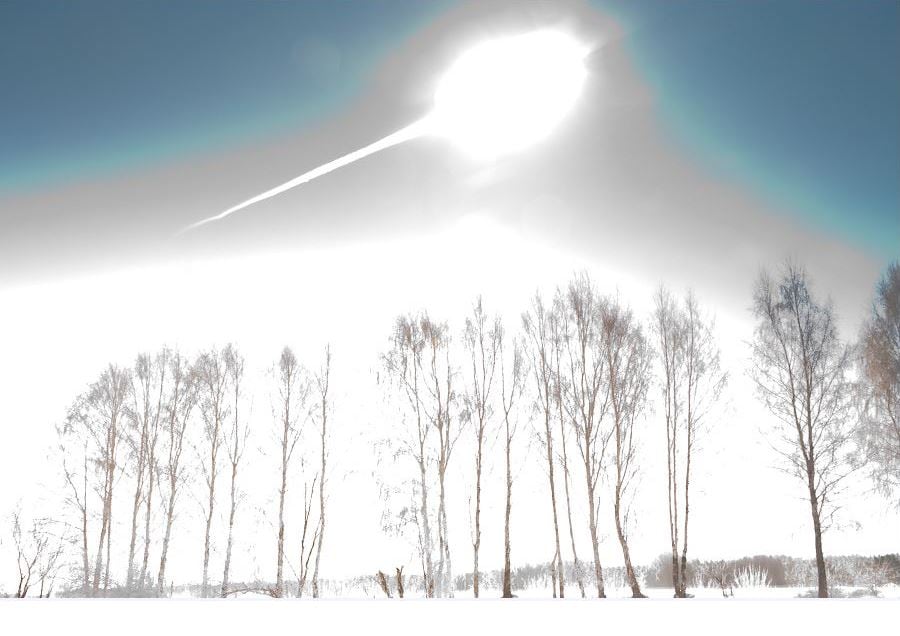 The Chelyabinsk meteor was just 17 metres wide. It exploded 29.7 km (18.4 m) up in the atmosphere over a relatively remote part of Russia. Its blast had the equivalent of 20-30 Hiroshima atomic bombs. 7,000 buildings were damaged and 1,500 people were injured. Imagine a meteor of that size exploding over London or New York. What would one just 30 metres wide do to those two cities? (Image: apod.nasa.gov)
The Chelyabinsk meteor was just 17 metres wide. It exploded 29.7 km (18.4 m) up in the atmosphere over a relatively remote part of Russia. Its blast had the equivalent of 20-30 Hiroshima atomic bombs. 7,000 buildings were damaged and 1,500 people were injured. Imagine a meteor of that size exploding over London or New York. What would one just 30 metres wide do to those two cities? (Image: apod.nasa.gov)
We know very little about asteroid strength
Dr. Bruck Syal said:
“There’s very little known about asteroid strength. We’re doing everything we can to know more about how asteroid materials respond under extreme conditions.”
Laura Chen, a postdoctoral researcher at the University of Oxford in England, has teamed up with Dr. Bruck Syal and is analysing data from recent experiments to help decide what type of laser pulses to use to extract the data they require from the rocks.
In order to capture all the data, the team also needs to get the right set of diagnostics in place.
Meanwhile, the rocks will be sent across the one-square mile Laboratory to Eric Strang, one of LLNL’s two master opticians. He will cut and polish the meteorites by hand down to thicknesses of tens of hundreds of microns, with sub-micron variances between each sample.
In the autumn, they will be mounted inside the target chamber at Lawrence Livermore’s Jupiter Laser Facility. There will be a countdown to a nanosecond laser pulse which will send a haymaker shockwave through the samples.
When the space rocks are vaporized and converted into data, they will have fulfilled their destiny.
 Russian scientists and the European Commission are collaborating on a project to use atomic weapons to stop Earth-bound killer asteroids from crashing into our planet.
Russian scientists and the European Commission are collaborating on a project to use atomic weapons to stop Earth-bound killer asteroids from crashing into our planet.
Knowing one is coming also important
We need to know about EVERY single celestial object coming our way, not just most of them.
The Chelyabinsk meteor, which injured nearly 1,500 people and damaged 7,000 buildings, was just 17 metres across and came in at a speed of 40,000 to 42,900 mph (60,000 to 69,000 km/h).
It was a complete surprise – nobody at all saw it coming!
That 2015 explosion, over a relatively remote part of Russia, had the equivalent force of between 20 and 30 Hiroshima nuclear bombs.
What is the good of eventually knowing how to effectively deflect killer asteroids if one catches us by surprise?
A large asteroid struck Earth near what is today the Yucatan Peninsula in the Caribbean sixty-five million years ago and probably caused the extinction of the dinosaur. That one was 6 miles (9.64 km) across.
A celestial body of that size striking our planet today would probably kill hundreds of millions of humans, perhaps evetually billions. Civilization as we know it would cease to exist.
Video – Unboxing the ancient space rocks
As soon as Dr. Bruck Syal received the box, she new what was inside – two 4.6 billion-year-old meteorites.
